Amazon's Approach to Sustainable Business Management Practices
VerifiedAdded on 2023/06/13
|8
|1721
|199
Report
AI Summary
This report examines Amazon's sustainable business management practices, focusing on the waste hierarchy framework and the triple bottom line theory. It identifies key sustainable challenges faced by Amazon, including environmental concerns like achieving net-zero carbon emissions and economic issues related to profitability during crises. The report details Amazon's initiatives, such as the Climate Pledge Fund and housing equity funds, and analyzes their approach to waste management through prevention, reuse, recycling, and responsible disposal. The conclusion highlights the ongoing challenges and the strategies Amazon employs to address social, environmental, and economic sustainability.
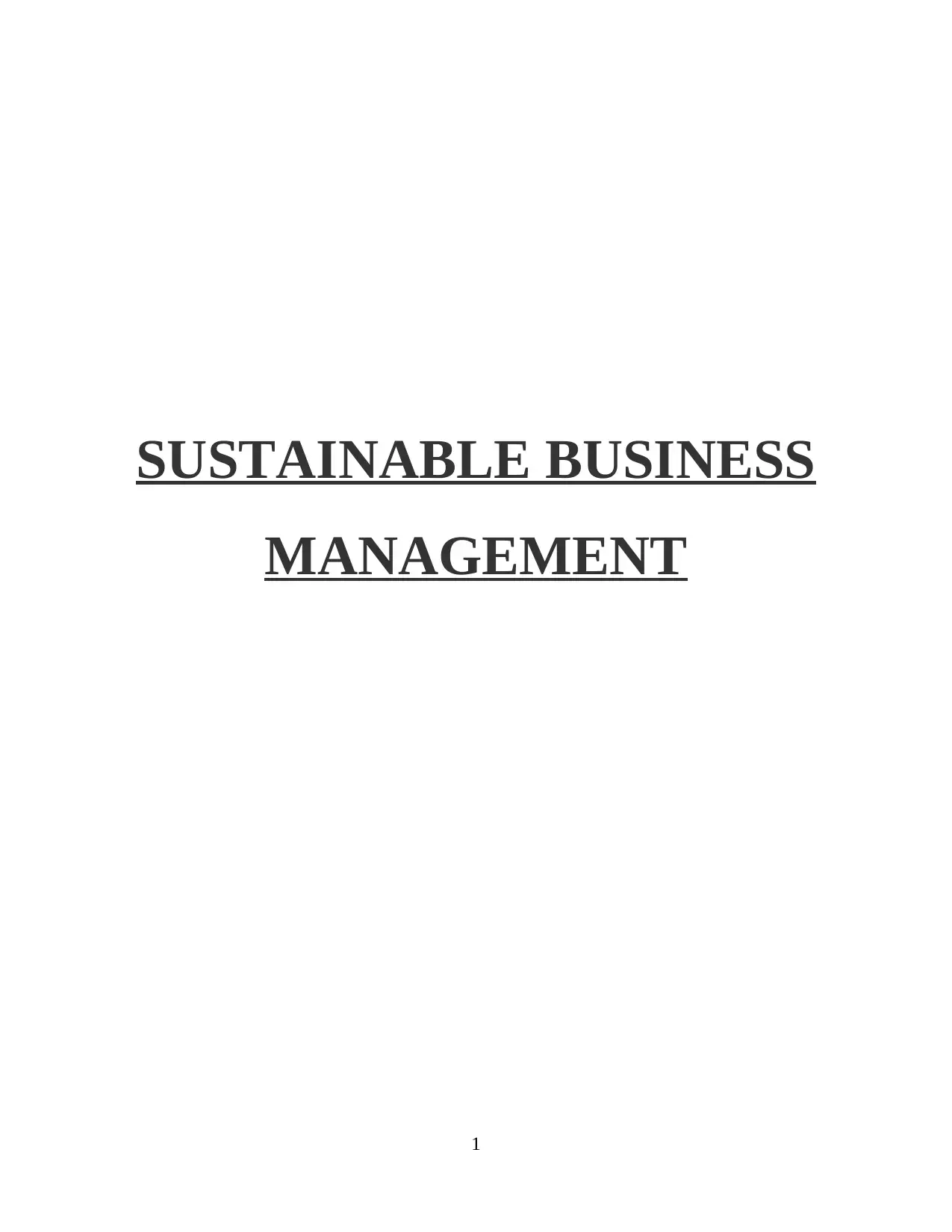
SUSTAINABLE BUSINESS
MANAGEMENT
1
MANAGEMENT
1
Paraphrase This Document
Need a fresh take? Get an instant paraphrase of this document with our AI Paraphraser
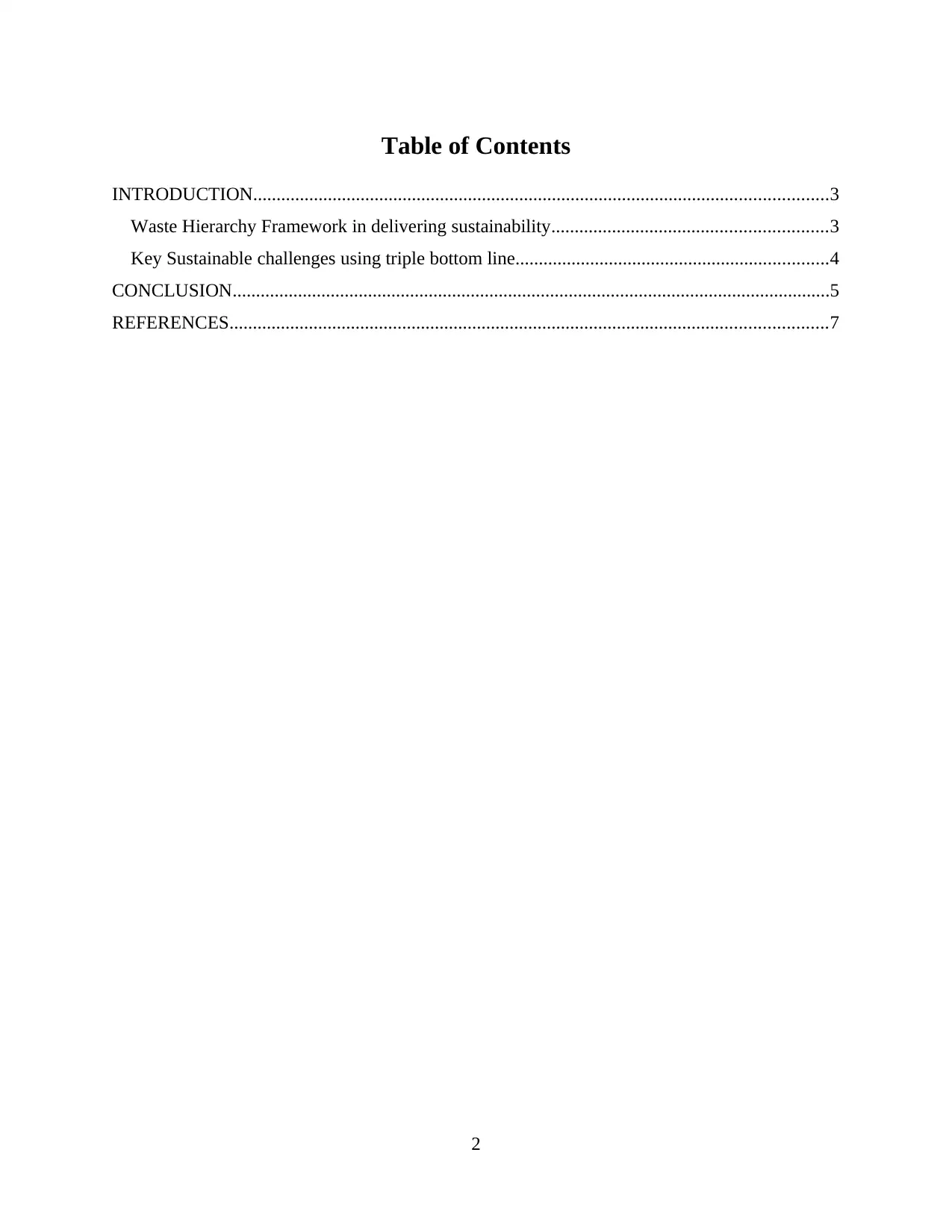
Table of Contents
INTRODUCTION...........................................................................................................................3
Waste Hierarchy Framework in delivering sustainability...........................................................3
Key Sustainable challenges using triple bottom line...................................................................4
CONCLUSION................................................................................................................................5
REFERENCES................................................................................................................................7
2
INTRODUCTION...........................................................................................................................3
Waste Hierarchy Framework in delivering sustainability...........................................................3
Key Sustainable challenges using triple bottom line...................................................................4
CONCLUSION................................................................................................................................5
REFERENCES................................................................................................................................7
2
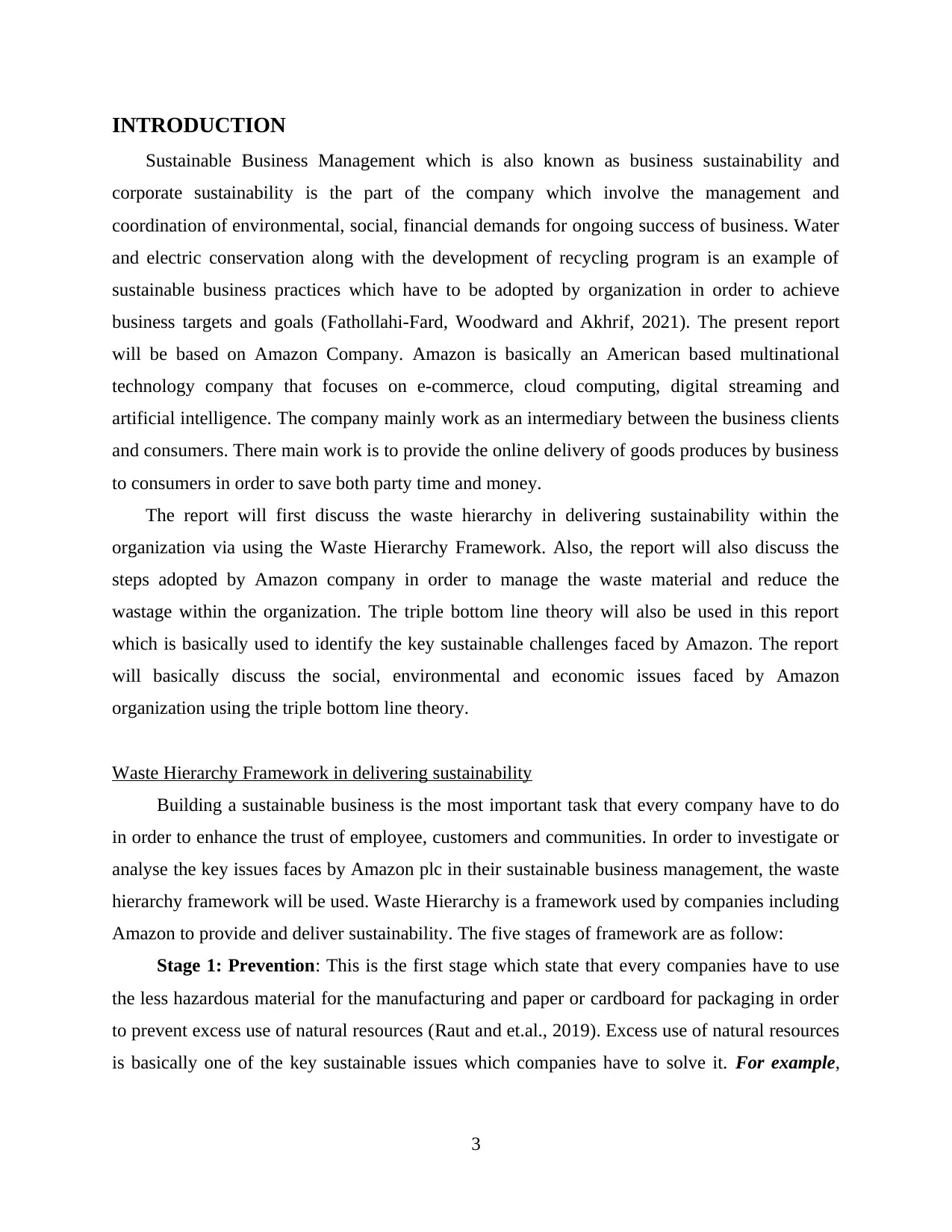
INTRODUCTION
Sustainable Business Management which is also known as business sustainability and
corporate sustainability is the part of the company which involve the management and
coordination of environmental, social, financial demands for ongoing success of business. Water
and electric conservation along with the development of recycling program is an example of
sustainable business practices which have to be adopted by organization in order to achieve
business targets and goals (Fathollahi-Fard, Woodward and Akhrif, 2021). The present report
will be based on Amazon Company. Amazon is basically an American based multinational
technology company that focuses on e-commerce, cloud computing, digital streaming and
artificial intelligence. The company mainly work as an intermediary between the business clients
and consumers. There main work is to provide the online delivery of goods produces by business
to consumers in order to save both party time and money.
The report will first discuss the waste hierarchy in delivering sustainability within the
organization via using the Waste Hierarchy Framework. Also, the report will also discuss the
steps adopted by Amazon company in order to manage the waste material and reduce the
wastage within the organization. The triple bottom line theory will also be used in this report
which is basically used to identify the key sustainable challenges faced by Amazon. The report
will basically discuss the social, environmental and economic issues faced by Amazon
organization using the triple bottom line theory.
Waste Hierarchy Framework in delivering sustainability
Building a sustainable business is the most important task that every company have to do
in order to enhance the trust of employee, customers and communities. In order to investigate or
analyse the key issues faces by Amazon plc in their sustainable business management, the waste
hierarchy framework will be used. Waste Hierarchy is a framework used by companies including
Amazon to provide and deliver sustainability. The five stages of framework are as follow:
Stage 1: Prevention: This is the first stage which state that every companies have to use
the less hazardous material for the manufacturing and paper or cardboard for packaging in order
to prevent excess use of natural resources (Raut and et.al., 2019). Excess use of natural resources
is basically one of the key sustainable issues which companies have to solve it. For example,
3
Sustainable Business Management which is also known as business sustainability and
corporate sustainability is the part of the company which involve the management and
coordination of environmental, social, financial demands for ongoing success of business. Water
and electric conservation along with the development of recycling program is an example of
sustainable business practices which have to be adopted by organization in order to achieve
business targets and goals (Fathollahi-Fard, Woodward and Akhrif, 2021). The present report
will be based on Amazon Company. Amazon is basically an American based multinational
technology company that focuses on e-commerce, cloud computing, digital streaming and
artificial intelligence. The company mainly work as an intermediary between the business clients
and consumers. There main work is to provide the online delivery of goods produces by business
to consumers in order to save both party time and money.
The report will first discuss the waste hierarchy in delivering sustainability within the
organization via using the Waste Hierarchy Framework. Also, the report will also discuss the
steps adopted by Amazon company in order to manage the waste material and reduce the
wastage within the organization. The triple bottom line theory will also be used in this report
which is basically used to identify the key sustainable challenges faced by Amazon. The report
will basically discuss the social, environmental and economic issues faced by Amazon
organization using the triple bottom line theory.
Waste Hierarchy Framework in delivering sustainability
Building a sustainable business is the most important task that every company have to do
in order to enhance the trust of employee, customers and communities. In order to investigate or
analyse the key issues faces by Amazon plc in their sustainable business management, the waste
hierarchy framework will be used. Waste Hierarchy is a framework used by companies including
Amazon to provide and deliver sustainability. The five stages of framework are as follow:
Stage 1: Prevention: This is the first stage which state that every companies have to use
the less hazardous material for the manufacturing and paper or cardboard for packaging in order
to prevent excess use of natural resources (Raut and et.al., 2019). Excess use of natural resources
is basically one of the key sustainable issues which companies have to solve it. For example,
3
⊘ This is a preview!⊘
Do you want full access?
Subscribe today to unlock all pages.

Trusted by 1+ million students worldwide
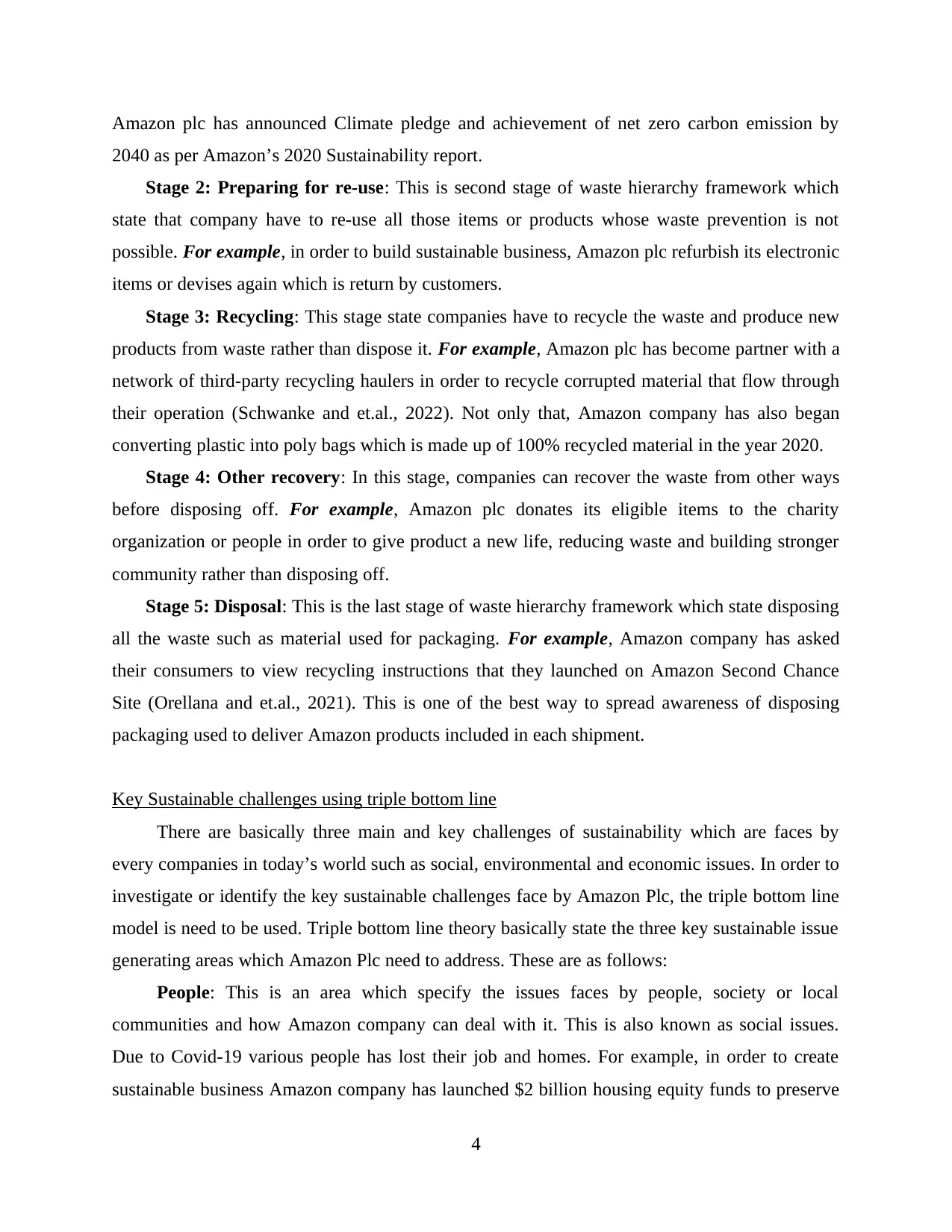
Amazon plc has announced Climate pledge and achievement of net zero carbon emission by
2040 as per Amazon’s 2020 Sustainability report.
Stage 2: Preparing for re-use: This is second stage of waste hierarchy framework which
state that company have to re-use all those items or products whose waste prevention is not
possible. For example, in order to build sustainable business, Amazon plc refurbish its electronic
items or devises again which is return by customers.
Stage 3: Recycling: This stage state companies have to recycle the waste and produce new
products from waste rather than dispose it. For example, Amazon plc has become partner with a
network of third-party recycling haulers in order to recycle corrupted material that flow through
their operation (Schwanke and et.al., 2022). Not only that, Amazon company has also began
converting plastic into poly bags which is made up of 100% recycled material in the year 2020.
Stage 4: Other recovery: In this stage, companies can recover the waste from other ways
before disposing off. For example, Amazon plc donates its eligible items to the charity
organization or people in order to give product a new life, reducing waste and building stronger
community rather than disposing off.
Stage 5: Disposal: This is the last stage of waste hierarchy framework which state disposing
all the waste such as material used for packaging. For example, Amazon company has asked
their consumers to view recycling instructions that they launched on Amazon Second Chance
Site (Orellana and et.al., 2021). This is one of the best way to spread awareness of disposing
packaging used to deliver Amazon products included in each shipment.
Key Sustainable challenges using triple bottom line
There are basically three main and key challenges of sustainability which are faces by
every companies in today’s world such as social, environmental and economic issues. In order to
investigate or identify the key sustainable challenges face by Amazon Plc, the triple bottom line
model is need to be used. Triple bottom line theory basically state the three key sustainable issue
generating areas which Amazon Plc need to address. These are as follows:
People: This is an area which specify the issues faces by people, society or local
communities and how Amazon company can deal with it. This is also known as social issues.
Due to Covid-19 various people has lost their job and homes. For example, in order to create
sustainable business Amazon company has launched $2 billion housing equity funds to preserve
4
2040 as per Amazon’s 2020 Sustainability report.
Stage 2: Preparing for re-use: This is second stage of waste hierarchy framework which
state that company have to re-use all those items or products whose waste prevention is not
possible. For example, in order to build sustainable business, Amazon plc refurbish its electronic
items or devises again which is return by customers.
Stage 3: Recycling: This stage state companies have to recycle the waste and produce new
products from waste rather than dispose it. For example, Amazon plc has become partner with a
network of third-party recycling haulers in order to recycle corrupted material that flow through
their operation (Schwanke and et.al., 2022). Not only that, Amazon company has also began
converting plastic into poly bags which is made up of 100% recycled material in the year 2020.
Stage 4: Other recovery: In this stage, companies can recover the waste from other ways
before disposing off. For example, Amazon plc donates its eligible items to the charity
organization or people in order to give product a new life, reducing waste and building stronger
community rather than disposing off.
Stage 5: Disposal: This is the last stage of waste hierarchy framework which state disposing
all the waste such as material used for packaging. For example, Amazon company has asked
their consumers to view recycling instructions that they launched on Amazon Second Chance
Site (Orellana and et.al., 2021). This is one of the best way to spread awareness of disposing
packaging used to deliver Amazon products included in each shipment.
Key Sustainable challenges using triple bottom line
There are basically three main and key challenges of sustainability which are faces by
every companies in today’s world such as social, environmental and economic issues. In order to
investigate or identify the key sustainable challenges face by Amazon Plc, the triple bottom line
model is need to be used. Triple bottom line theory basically state the three key sustainable issue
generating areas which Amazon Plc need to address. These are as follows:
People: This is an area which specify the issues faces by people, society or local
communities and how Amazon company can deal with it. This is also known as social issues.
Due to Covid-19 various people has lost their job and homes. For example, in order to create
sustainable business Amazon company has launched $2 billion housing equity funds to preserve
4
Paraphrase This Document
Need a fresh take? Get an instant paraphrase of this document with our AI Paraphraser
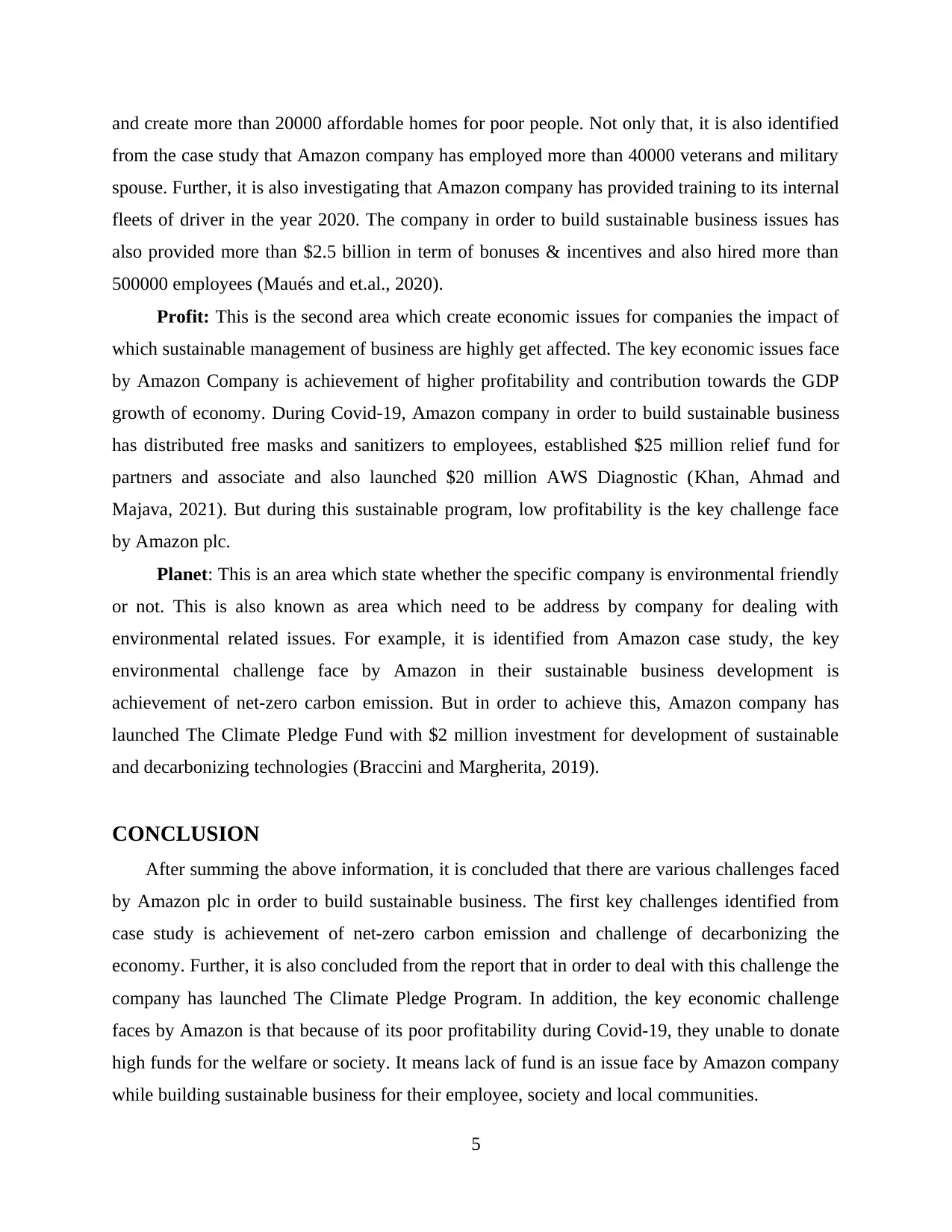
and create more than 20000 affordable homes for poor people. Not only that, it is also identified
from the case study that Amazon company has employed more than 40000 veterans and military
spouse. Further, it is also investigating that Amazon company has provided training to its internal
fleets of driver in the year 2020. The company in order to build sustainable business issues has
also provided more than $2.5 billion in term of bonuses & incentives and also hired more than
500000 employees (Maués and et.al., 2020).
Profit: This is the second area which create economic issues for companies the impact of
which sustainable management of business are highly get affected. The key economic issues face
by Amazon Company is achievement of higher profitability and contribution towards the GDP
growth of economy. During Covid-19, Amazon company in order to build sustainable business
has distributed free masks and sanitizers to employees, established $25 million relief fund for
partners and associate and also launched $20 million AWS Diagnostic (Khan, Ahmad and
Majava, 2021). But during this sustainable program, low profitability is the key challenge face
by Amazon plc.
Planet: This is an area which state whether the specific company is environmental friendly
or not. This is also known as area which need to be address by company for dealing with
environmental related issues. For example, it is identified from Amazon case study, the key
environmental challenge face by Amazon in their sustainable business development is
achievement of net-zero carbon emission. But in order to achieve this, Amazon company has
launched The Climate Pledge Fund with $2 million investment for development of sustainable
and decarbonizing technologies (Braccini and Margherita, 2019).
CONCLUSION
After summing the above information, it is concluded that there are various challenges faced
by Amazon plc in order to build sustainable business. The first key challenges identified from
case study is achievement of net-zero carbon emission and challenge of decarbonizing the
economy. Further, it is also concluded from the report that in order to deal with this challenge the
company has launched The Climate Pledge Program. In addition, the key economic challenge
faces by Amazon is that because of its poor profitability during Covid-19, they unable to donate
high funds for the welfare or society. It means lack of fund is an issue face by Amazon company
while building sustainable business for their employee, society and local communities.
5
from the case study that Amazon company has employed more than 40000 veterans and military
spouse. Further, it is also investigating that Amazon company has provided training to its internal
fleets of driver in the year 2020. The company in order to build sustainable business issues has
also provided more than $2.5 billion in term of bonuses & incentives and also hired more than
500000 employees (Maués and et.al., 2020).
Profit: This is the second area which create economic issues for companies the impact of
which sustainable management of business are highly get affected. The key economic issues face
by Amazon Company is achievement of higher profitability and contribution towards the GDP
growth of economy. During Covid-19, Amazon company in order to build sustainable business
has distributed free masks and sanitizers to employees, established $25 million relief fund for
partners and associate and also launched $20 million AWS Diagnostic (Khan, Ahmad and
Majava, 2021). But during this sustainable program, low profitability is the key challenge face
by Amazon plc.
Planet: This is an area which state whether the specific company is environmental friendly
or not. This is also known as area which need to be address by company for dealing with
environmental related issues. For example, it is identified from Amazon case study, the key
environmental challenge face by Amazon in their sustainable business development is
achievement of net-zero carbon emission. But in order to achieve this, Amazon company has
launched The Climate Pledge Fund with $2 million investment for development of sustainable
and decarbonizing technologies (Braccini and Margherita, 2019).
CONCLUSION
After summing the above information, it is concluded that there are various challenges faced
by Amazon plc in order to build sustainable business. The first key challenges identified from
case study is achievement of net-zero carbon emission and challenge of decarbonizing the
economy. Further, it is also concluded from the report that in order to deal with this challenge the
company has launched The Climate Pledge Program. In addition, the key economic challenge
faces by Amazon is that because of its poor profitability during Covid-19, they unable to donate
high funds for the welfare or society. It means lack of fund is an issue face by Amazon company
while building sustainable business for their employee, society and local communities.
5
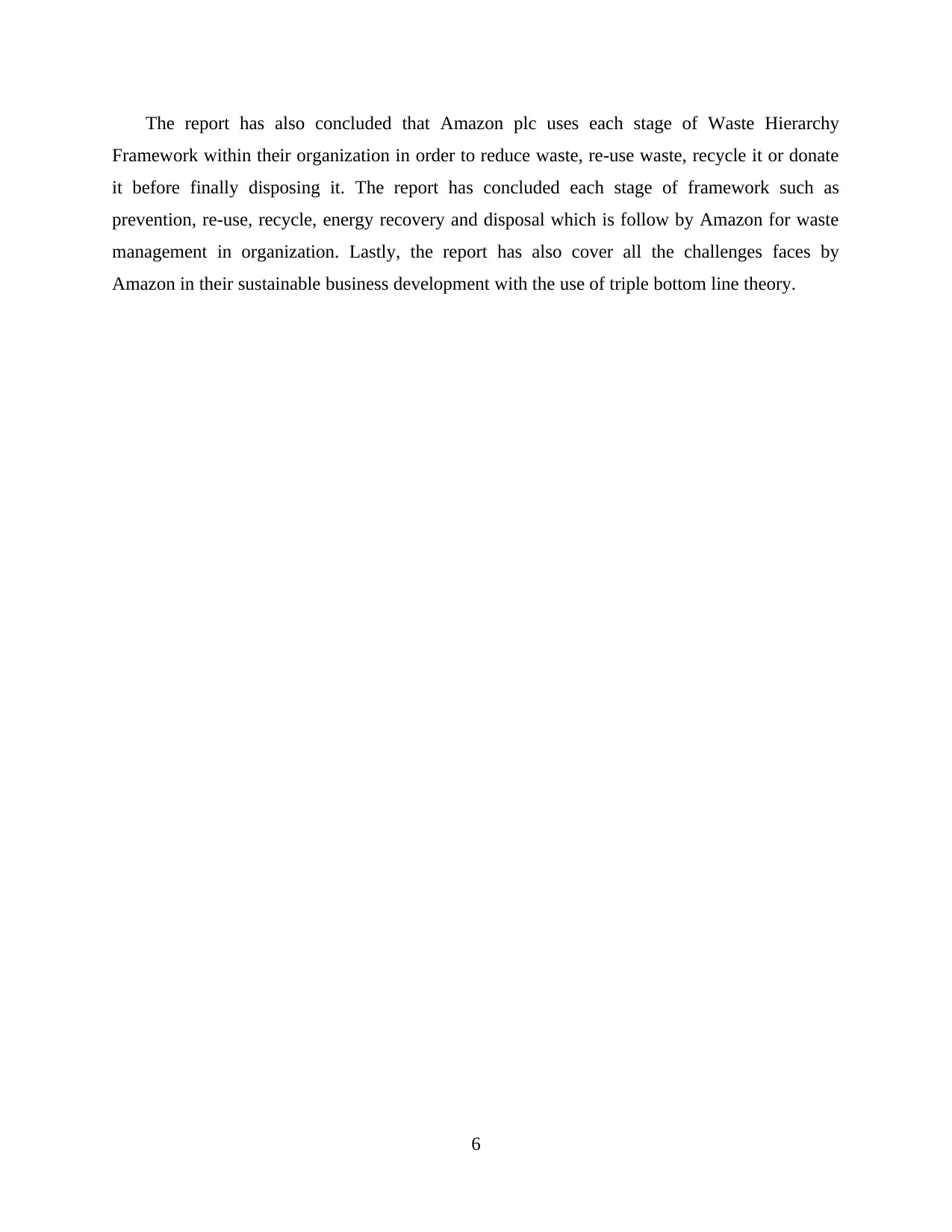
The report has also concluded that Amazon plc uses each stage of Waste Hierarchy
Framework within their organization in order to reduce waste, re-use waste, recycle it or donate
it before finally disposing it. The report has concluded each stage of framework such as
prevention, re-use, recycle, energy recovery and disposal which is follow by Amazon for waste
management in organization. Lastly, the report has also cover all the challenges faces by
Amazon in their sustainable business development with the use of triple bottom line theory.
6
Framework within their organization in order to reduce waste, re-use waste, recycle it or donate
it before finally disposing it. The report has concluded each stage of framework such as
prevention, re-use, recycle, energy recovery and disposal which is follow by Amazon for waste
management in organization. Lastly, the report has also cover all the challenges faces by
Amazon in their sustainable business development with the use of triple bottom line theory.
6
⊘ This is a preview!⊘
Do you want full access?
Subscribe today to unlock all pages.

Trusted by 1+ million students worldwide
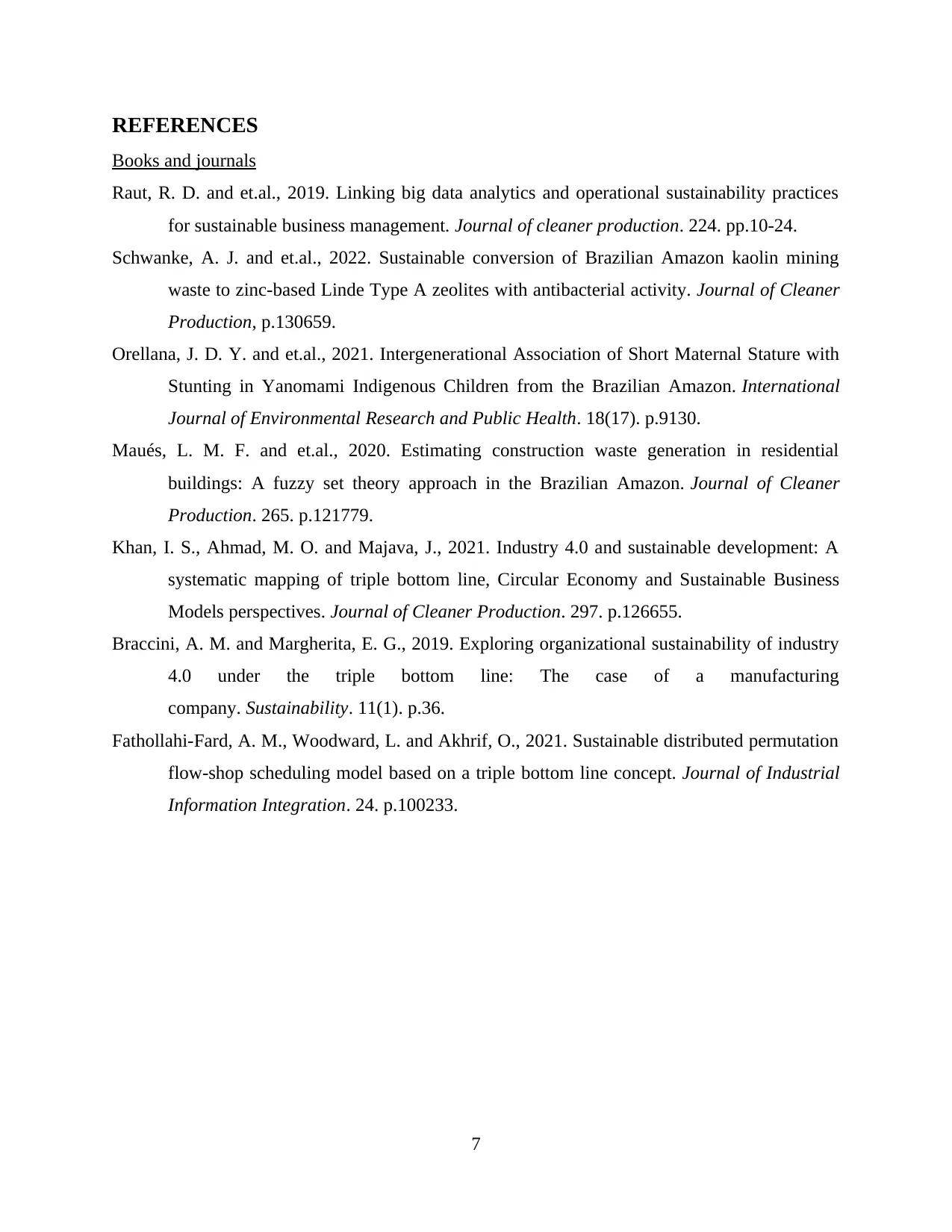
REFERENCES
Books and journals
Raut, R. D. and et.al., 2019. Linking big data analytics and operational sustainability practices
for sustainable business management. Journal of cleaner production. 224. pp.10-24.
Schwanke, A. J. and et.al., 2022. Sustainable conversion of Brazilian Amazon kaolin mining
waste to zinc-based Linde Type A zeolites with antibacterial activity. Journal of Cleaner
Production, p.130659.
Orellana, J. D. Y. and et.al., 2021. Intergenerational Association of Short Maternal Stature with
Stunting in Yanomami Indigenous Children from the Brazilian Amazon. International
Journal of Environmental Research and Public Health. 18(17). p.9130.
Maués, L. M. F. and et.al., 2020. Estimating construction waste generation in residential
buildings: A fuzzy set theory approach in the Brazilian Amazon. Journal of Cleaner
Production. 265. p.121779.
Khan, I. S., Ahmad, M. O. and Majava, J., 2021. Industry 4.0 and sustainable development: A
systematic mapping of triple bottom line, Circular Economy and Sustainable Business
Models perspectives. Journal of Cleaner Production. 297. p.126655.
Braccini, A. M. and Margherita, E. G., 2019. Exploring organizational sustainability of industry
4.0 under the triple bottom line: The case of a manufacturing
company. Sustainability. 11(1). p.36.
Fathollahi-Fard, A. M., Woodward, L. and Akhrif, O., 2021. Sustainable distributed permutation
flow-shop scheduling model based on a triple bottom line concept. Journal of Industrial
Information Integration. 24. p.100233.
7
Books and journals
Raut, R. D. and et.al., 2019. Linking big data analytics and operational sustainability practices
for sustainable business management. Journal of cleaner production. 224. pp.10-24.
Schwanke, A. J. and et.al., 2022. Sustainable conversion of Brazilian Amazon kaolin mining
waste to zinc-based Linde Type A zeolites with antibacterial activity. Journal of Cleaner
Production, p.130659.
Orellana, J. D. Y. and et.al., 2021. Intergenerational Association of Short Maternal Stature with
Stunting in Yanomami Indigenous Children from the Brazilian Amazon. International
Journal of Environmental Research and Public Health. 18(17). p.9130.
Maués, L. M. F. and et.al., 2020. Estimating construction waste generation in residential
buildings: A fuzzy set theory approach in the Brazilian Amazon. Journal of Cleaner
Production. 265. p.121779.
Khan, I. S., Ahmad, M. O. and Majava, J., 2021. Industry 4.0 and sustainable development: A
systematic mapping of triple bottom line, Circular Economy and Sustainable Business
Models perspectives. Journal of Cleaner Production. 297. p.126655.
Braccini, A. M. and Margherita, E. G., 2019. Exploring organizational sustainability of industry
4.0 under the triple bottom line: The case of a manufacturing
company. Sustainability. 11(1). p.36.
Fathollahi-Fard, A. M., Woodward, L. and Akhrif, O., 2021. Sustainable distributed permutation
flow-shop scheduling model based on a triple bottom line concept. Journal of Industrial
Information Integration. 24. p.100233.
7
Paraphrase This Document
Need a fresh take? Get an instant paraphrase of this document with our AI Paraphraser

8
1 out of 8
Related Documents
Your All-in-One AI-Powered Toolkit for Academic Success.
+13062052269
info@desklib.com
Available 24*7 on WhatsApp / Email
![[object Object]](/_next/static/media/star-bottom.7253800d.svg)
Unlock your academic potential
Copyright © 2020–2025 A2Z Services. All Rights Reserved. Developed and managed by ZUCOL.




